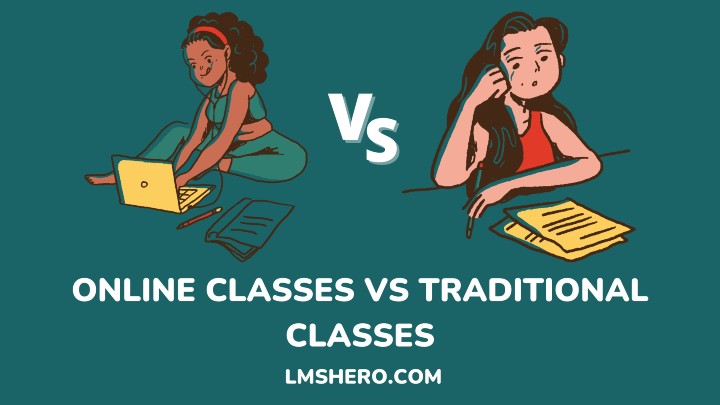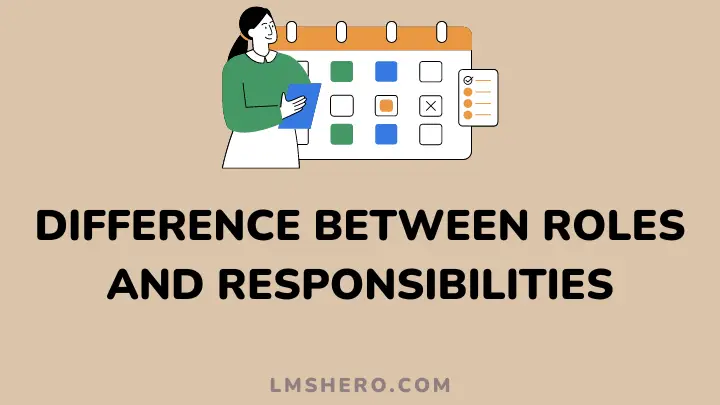Most people think that online classes vs traditional classes are an irrelevant subject. This isn’t exactly true. Even though they have many similarities, they have more differences.
Online classes, also known as E-learning or web-based training, are types of education, whereby learning occurs through digital media. While in traditional classrooms, the teacher instructs you in a physical classroom where everyone can see and talk to each other.
The difference between online classes vs traditional classes depends on the situation, which we will discuss below.
Even with the fast developments of technology, some people still prefer to attend a traditional class instead of taking an online class. However, are there advantages and disadvantages to attending each school?
This article examines how these schools work and elaborates on the differences between online classes vs traditional classes.
What Are Online Classes?
Online classes are internet-based, self-paced courses that allow for participation anywhere there is a web connection. These are courses that exist over the internet at any time. Also, these classes meet your convenience and accessibility requirements.
Online classes come in two forms: synchronous and asynchronous. Synchronous classes are scheduled like traditional, face-to-face classes and require you to log into virtual platforms to learn at a specific time. Asynchronous classes have no mandatory set meeting time.
Online classes are a convenient way to earn a degree. Currently, more than 40 percent of college students take online courses. Also, online classes include all the same lessons material, and knowledge that you would get in a traditional college classroom.
These classes allow you to complete your work from anywhere you have an internet connection. They also allow you the time and flexibility to learn at your own pace in a way that fits your schedule.
What Are Traditional Classes?
Traditional classes are any classes that require you to attend lectures and seminars in person. These classes meet at scheduled times and coursework takes place in the classroom or nearby location.
Additionally, in traditional classrooms, students, instructors, and sometimes a facilitator interact with each other. The teacher goes over the lesson, and you complete assignments during that class period or later on.
Furthermore, you will be able to interact physically with your instructor and classmates as well as use campus resources, including the library. In-person, instructor-led classes offer many benefits and drawbacks to their online counterparts.
Many people find that traditional classes, with live lectures and hands-on activities, allow for better understanding and more enjoyment of the subject matter.
What Are the Benefits of Online and Traditional Classes?
When considering online classes vs. traditional classes, you should consider your own study habits and lifestyle.
Online courses take place on a computer, allowing for maximum flexibility. They often have lower tuition than in-person courses and more flexible scheduling options.
Traditional classroom courses occur at specific times, usually in person at your school’s campus. They may require more time per week but often allow for face-to-face interactions with your fellow students and the instructor.
Online and traditional classes are two types of learning, both of which have their fair share of pros and cons. All students need to do some deep thinking about what will be best for them.
Benefits of Online Classes
Online classes are popular because they can be flexible and affordable. Students can also often choose from a multitude of options.
While online classes do not provide students with all of the physical aspects of a traditional class, there are still many benefits to choosing it, including freedom, independence, and the ability to make your own schedule.
Also, these classes provide more flexibility for individuals who have busy schedules and need to learn at their own pace. Students can also work ahead and go back to the material when necessary.
They get the chance to review materials that may have been challenging to learn on their first attempt.
With most classes taking place online, programs are able to cut expenses related to housing and accommodations, and many other resources. As a result, students benefit from lower tuition prices.
Benefits of Traditional Classes
Traditional classes might seem intimidating, but they can provide many benefits that you might not get from an online class.
One of the major benefits of traditional classroom learning is the convenience of attending classes in a physical area. That means you’re able to talk with your teachers in person and have face-to-face communication.
Also, it can help get you the individualized attention you need if you have questions, or need help with any material taught to you in class.
When you take a class in person, you’re more likely to stay motivated, interact with your professor, and stick to an effective study schedule than if you were taking courses online.
What Are the Disadvantages of Online and Traditional Classes?
Online classes can be as rigorous as traditional classes and may require just as much work. However, it may require less time in class if the courses are asynchronous. Recorded classes are asynchronous, so you can attend them at your convenience.
A student’s time management skills apply to both traditional and online classes. However, other differences such as cost, curriculum, and educational outcomes may convince you that one choice is better than the other.
Here are several disadvantages some students experience in each of these learning environments.
What Are the Disadvantages of Online Classes?
The biggest disadvantage of online education is the lack of interpersonal communication. Some people learn better in an environment where they can talk directly with their professors and fellow classmates.
In addition, without face-to-face interaction, lectures can become isolating and difficult to understand.
You don’t physically attend the college where you are studying, and you don’t get to interact directly with other students. An online course also requires a reasonably fast and stable internet connection.
Listed below are some major disadvantages of online classes:
1. You Miss a Lot of the Social Interaction
Online classes are run by professionals who know how to teach, yet you miss some of the social interaction of interacting with a live instructor. You often learn from text documents and recorded videos instead of from each other.
Unfortunately, you miss out on most of the class environment, and some of the interactions that help you understand what you are learning. Also, the environment is more sterile, impersonal, and less structured.
2. Less Opportunity to Collaborate
In these classes, students often have trouble connecting and collaborating with other students. They offer little or no opportunity to collaborate thereby since most students are far apart.
This sometimes also contributes to a lack of interaction among students.
3. It’s Harder to Source Help from Your Teachers
Except for virtual classes where classes occur in real-time, students find it difficult to get help from most online teachers. In most cases, online lectures are pre-recorded and hosted on platforms where communication with the tutor is limited.
That makes it harder for a confused student to seek help from a tutor. Also, most students have to conduct hours of research on the internet to solve their issues when a simple consultation with the teacher could solve that.
4. You Are Unable to Gain Practical Experience through Online Classes
Unlike traditional schooling where students collaborate to conduct experiments during practical classes, most online classes only follow the theoretical approach.
The limited ability to gain practical experience in these classes makes it difficult for students to offer courses like medicine and engineering online.
5. Some Online Courses Aren’t Recognized by Colleges/Universities
True, the evolution of online learning has resulted in the availability of so many helpful and informative resources.
However, despite providing so many authentic learning materials, the online learning platform is also filled with bogus content made by crooked or fake tutors only interested in making fast money.
Most of these courses are unhelpful and unrecognized by appropriate organizations.
What Are the Disadvantages of Traditional Classes?
Traditional classes or in-person education may be very effective, but it can also be difficult to attend.
It may require a student to leave home and move to a new location, and it might mean a family must uproot their lives for the sake of their child’s education.
Also, it can be costly in terms of time and money due to the travel required.
Listed below are some major disadvantages of traditional classes:
1. Traditional Classes Don’t Offer Flexibility Like Online Classes
Classes are generally more expensive and you’ll rarely find courses with the kind of flexible schedules that many of you are looking for.
That is because classes can only occur at physical locations, and you have to show up. You can, however, study online at your own pace and according to your schedule due to its flexibility.
2. In a Traditional Class, You Can’t Pause or Rewind the Class to Understand the Material
You cannot pause or rewind a traditional class to understand the material. Also, teachers rely on lecture notes that are often unintelligible to most students due to their lack of visual or graphical representations.
3. Traditional Classes Are More Expensive
Traditional classes are more expensive than online classes. More advanced infrastructures, equipment, and skills are required to teach in a traditional school.
4. Less Networking Opportunities than Online Classes
You have limited networking opportunities in traditional classes and might be limited to the resources within the school.
Online learning, however, grants you access to a diverse network of support and experts that can assist you during and after your program.
5. Traditional Classes Require Spending Money on Transportation
The advantages of traditional classes are that you can interact with your classmates and learn in person! However, you also need to spend money on transportation to be there.
FAQs
Are online classes better than traditional classes?
No, online classes are not necessarily better than traditional classes. What they offer in convenience, they lack in interaction.
Taking online classes is more convenient than attending traditional classes at a particular time and place. You can take online classes to advance your skillset, shift careers or even achieve personal goals.
Are online classes the same as virtual classes?
No, online classes are not entirely the same as virtual classes. Online classes include the synchronous and asynchronous aspects of e-learning over the internet. Virtual classes, however, refer to just the synchronous aspect of online education.
Synchronous online classes refer to learning online in real-time through online virtual platforms like Zoom or Blackboard. Asynchronous online classes, however, refer to learning online through the aid of pre-recorded videos or uploaded materials.
What is the difference between online classes and hybrid learning?
Hybrid learning combines online classes and traditional face-to-face learning in a classroom. Online classes, however, are lectures delivered strictly over the internet via video, text, or audio.
Also, online classes are great for busy parents, people with disabilities, or career people who simply do not have the time to learn in a physical classroom.
Are MOOC platforms great for online learners?
Yes, Massive Open Online Courses (MOOC) platforms are great online educational choices for learners. You can take advantage of these platforms for free and learn new skills or advance in your career.
Also, if you want to learn something new, MOOCs make this process of choice and self-discovery easier. And if you want to take a class from an expert, you can get your learning done at home or on the go.
Conclusion
Online classes and the internet have become very popular among students, teachers, and employees. It’s easier to compile class lists online or find answers to your questions online because you can search thousands of websites.
However, traditional classes can be fun and interactive. They offer a structured and controlled environment while allowing students to apply their knowledge directly to real-world situations.
Finally, you can determine which type of education is right for you by comparing online classes vs traditional classes. However, should you choose online learning as the path for you, here are some of the best online learning platforms you can use.
I hope you found this article helpful.
Thanks for reading.






